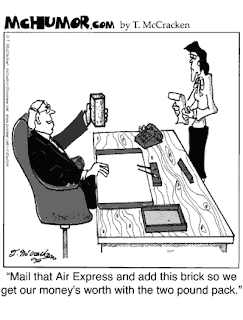Seal the envelope, slap on a stamp and put the red flag up on the mailbox. Easy enough. But what happens when you want to mail something to 20,000 people? It might not fit in your mailbox, but it can be just as easy – as long as you know what you’re getting into.
I’ll go ahead and preface this with: I could never give you all of the information you’d need to undertake a successful and competitively priced bulk mailing. Consider this a precursor to your research.
First, make sure you do your homework, even if you are working with a professional mail service vendor. If you don’t know what questions to ask, they might not tell you. You can easily end up learning an expensive lesson (Trust me. I know.).
Be sure to check postal rates and class regulations. There are tricks and loopholes all along the way. For example, sending an oversized postcard costs less than the standard 44 cent stamp, but if you have “Return Service Requested” printed on the back, you will be changed the full 44 cents for each returned piece. Also, you might pay the same postage for a 20-page catalog as you would a 40-page catalogue, so don’t assume anything when it comes to postage and regulations! It’s one of the most important areas to research.
Now, if you’re a nonprofit and low on cash flow, there’s good news. Nonprofits get a discount. Even though you’re eligible for a postage discount, you need to file paperwork with the post office. And this might seem obvious, but don’t forget to include a return address. That one small omission will cost you for profit prices.
And then, there’s the dreaded distribution list. Thousands of addresses – a never-ending scroll through Excel. So what if your list is old and you don’t want to pay to send your mail piece to thousands of invalid or old address? Don’t worry! Most mail vendors offer a list-cleaning service that will pull invalid addresses and inform you if someone has moved.
Good luck to all of you direct mailers out there! And feel free to email me if you want to know what question I didn’t know to ask our mail vendor.
Or don’t. I’m trying to forget about it!

 As design director at Cookerly, Tim serves as the creative lead in the development of branding campaigns, print collateral and digital media for clients across a broad range of industries, including consumer, professional services, healthcare and technology.
As design director at Cookerly, Tim serves as the creative lead in the development of branding campaigns, print collateral and digital media for clients across a broad range of industries, including consumer, professional services, healthcare and technology. As a senior vice president at Cookerly, Mike Rieman is a strategic communications leader specializing in media relations and reputation management. With a proven track record of securing high-profile placements in top-tier outlets such as The New York Times, The Wall Street Journal, CNN and USA Today, he excels at crafting compelling narratives that resonate across print, broadcast and digital platforms.
As a senior vice president at Cookerly, Mike Rieman is a strategic communications leader specializing in media relations and reputation management. With a proven track record of securing high-profile placements in top-tier outlets such as The New York Times, The Wall Street Journal, CNN and USA Today, he excels at crafting compelling narratives that resonate across print, broadcast and digital platforms. Mike Touhill is vice president at Cookerly Public Relations, where he helps lead traditional, social and digital media programs for B2B and B2C clients in packaging, telecommunications and technology, among other industries. As a communication leader, he develops and executes public relations strategy, provides proactive and reactive counsel to C-level executives and secures earned media coverage for client initiatives and product.
Mike Touhill is vice president at Cookerly Public Relations, where he helps lead traditional, social and digital media programs for B2B and B2C clients in packaging, telecommunications and technology, among other industries. As a communication leader, he develops and executes public relations strategy, provides proactive and reactive counsel to C-level executives and secures earned media coverage for client initiatives and product. Andrew Agan is a vice president at Cookerly Public Relations, overseeing the agency’s internship program and leading media relations, content strategy and social media initiatives. He provides counsel and executes campaigns for clients across various sectors, including finance, healthcare, hospitality, technology, automotive and many others. Andrew excels at crafting compelling stories and building media relationships, resulting in clients being featured in notable outlets such as CNBC, Associated Press, Business Insider, Fox Business, HBO, Inc. Magazine, Sirius XM, The Wall Street Journal and USA Today, among others.
Andrew Agan is a vice president at Cookerly Public Relations, overseeing the agency’s internship program and leading media relations, content strategy and social media initiatives. He provides counsel and executes campaigns for clients across various sectors, including finance, healthcare, hospitality, technology, automotive and many others. Andrew excels at crafting compelling stories and building media relationships, resulting in clients being featured in notable outlets such as CNBC, Associated Press, Business Insider, Fox Business, HBO, Inc. Magazine, Sirius XM, The Wall Street Journal and USA Today, among others.


 As vice president of Cookerly, Sheryl Sellaway uses her extensive corporate communications background to lead consumer PR efforts, deliver strategy for marketing programs and share expertise about community initiatives.
As vice president of Cookerly, Sheryl Sellaway uses her extensive corporate communications background to lead consumer PR efforts, deliver strategy for marketing programs and share expertise about community initiatives.